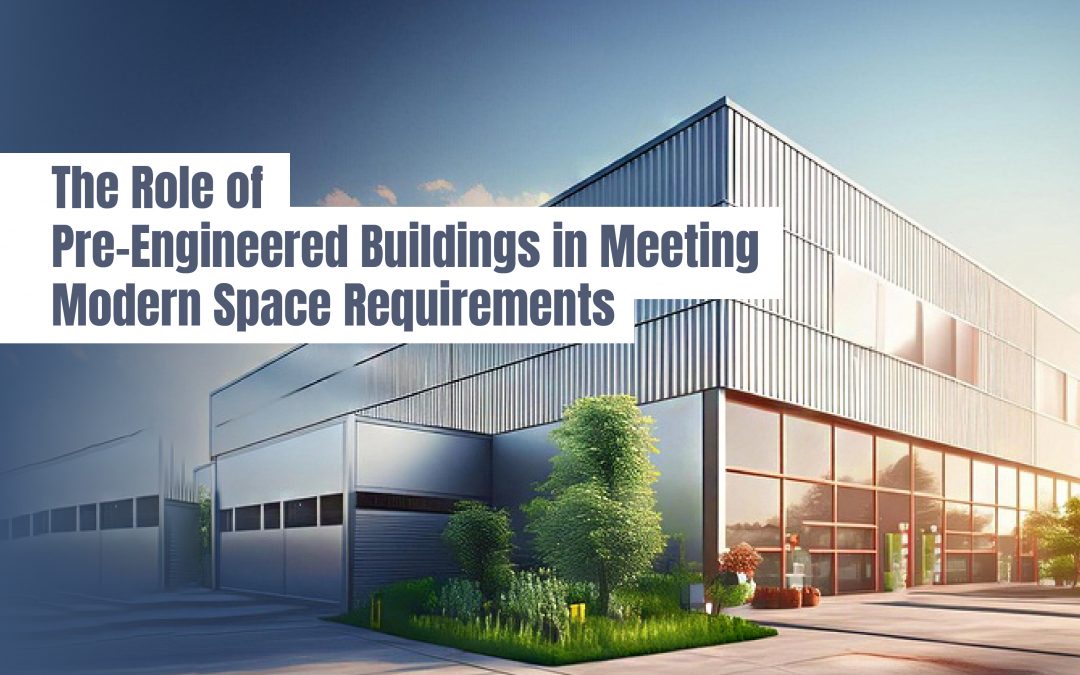In today’s fast-paced world, businesses and industries face a growing demand for flexible, scalable, and efficient space solutions. Traditional construction methods often fall short in addressing these evolving needs, leading to increased interest in pre-engineered buildings (PEBs). These structures are transforming the construction landscape by providing innovative solutions that align with modern requirements. Let’s explore how pre-engineered buildings are meeting the demands for adaptable and scalable spaces.
1. Flexibility in Design and Functionality
Pre-engineered buildings offer unparalleled flexibility in design, making them ideal for a wide range of applications. Whether it’s a warehouse, manufacturing facility, retail store, or office space, PEBs can be customized to meet specific requirements. The modular nature of these structures allows for easy reconfiguration and expansion, accommodating changes in business operations or growth.
For example, a warehouse initially designed for storage can be adapted to include office spaces, meeting rooms, or even retail areas without significant renovations. This adaptability is crucial for businesses that need to quickly respond to market changes or evolving operational needs.
2. Rapid Construction and Reduced Downtime
One of the standout benefits of pre-engineered buildings is the speed of construction. Since components are pre-fabricated in a factory setting, on-site assembly is streamlined and efficient. This rapid construction process significantly reduces downtime, allowing businesses to occupy their spaces sooner and minimize disruption to operations.
In industries where time is critical, such as logistics and manufacturing, the ability to quickly erect a functional building can be a game-changer. Businesses can get up and running faster, improving their overall productivity and competitive edge.
3. Cost-Effectiveness and Budget Control
Pre-engineered buildings are known for their cost-effectiveness. The streamlined design and manufacturing process reduce labor costs and material waste, leading to significant savings compared to traditional construction methods. Additionally, the efficient assembly of pre-fabricated components minimizes unexpected expenses during construction.
Businesses benefit from predictable costs and shorter construction timelines, which contribute to better budget control. For many companies, this cost efficiency makes pre-engineered buildings a financially attractive option.
4. Scalable Solutions for Growing Businesses
As businesses grow, their space requirements often change. Pre-engineered buildings offer scalable solutions that can easily accommodate growth. Structures can be expanded or modified with minimal disruption, allowing companies to adapt their facilities to changing needs.
For instance, a growing manufacturing plant can add additional bays or production lines without a complete overhaul of the existing structure. This scalability is particularly valuable for startups and expanding businesses looking to avoid the constraints of traditional building designs.
5. Sustainability and Energy Efficiency
Sustainability is a key consideration for modern businesses, and pre-engineered buildings often excel in this area. Many PEBs are designed with energy-efficient features such as insulation, ventilation systems, and sustainable materials. These elements contribute to reduced energy consumption and lower operational costs.
Furthermore, the efficient construction process and reduced waste associated with pre-engineered buildings align with green building practices. This commitment to sustainability helps businesses meet environmental regulations and appeal to eco-conscious consumers.
6. Adaptability to Various Climates and Locations
Pre-engineered buildings are designed to perform well in diverse climates and locations. Whether it’s a high-altitude region, a coastal area prone to storms, or an extreme climate, PEBs can be engineered to withstand environmental conditions. This adaptability ensures that businesses can establish operations in a wide range of geographical locations without compromising on structural integrity.
7. Enhanced Aesthetic Appeal
While functionality is a primary concern, modern pre-engineered buildings also offer aesthetic flexibility. With advancements in design and materials, PEBs can be customized to achieve a variety of architectural styles and finishes. This allows businesses to create a visually appealing structure that aligns with their brand identity and corporate image.
Real-World Examples and Benefits
Pre-engineered buildings (PEBs) have been instrumental in supporting various modern business models across different industries. Here are some notable examples of how PEBs have been utilized to support contemporary business needs:
1. E-commerce Warehouses
Amazon Fulfillment Centers
- Overview: Amazon’s expansive fulfillment centers are prime examples of how pre-engineered buildings support e-commerce. These PEBs are designed for high efficiency, featuring vast open spaces for inventory management, automated systems, and rapid processing of orders.
- Benefits: The flexibility and scalability of PEBs allow Amazon to quickly expand these centers as demand increases, supporting the company’s rapid growth and high-volume operations.
2. Manufacturing Facilities
Tesla Gigafactory
- Overview: Tesla’s Gigafactory in Nevada is a significant pre-engineered building project dedicated to manufacturing electric vehicle batteries and powertrains. The facility’s design focuses on maximizing production efficiency and scalability.
- Benefits: The modular nature of PEBs allows Tesla to expand the factory in stages, accommodating increasing production needs and integrating advanced manufacturing technologies.
3. Retail Stores
Lowe’s Home Improvement Stores
- Overview: Lowe’s uses pre-engineered buildings for its retail stores across the U.S. These structures are designed to provide flexible retail spaces with customizable layouts and efficient building systems.
- Benefits: PEBs enable Lowe’s to quickly establish new store locations while maintaining a consistent brand image and operational efficiency.
4. Sports and Recreation Facilities
Tennis and Racquet Clubs
- Overview: Many tennis and racquet clubs use pre-engineered buildings to create indoor courts and recreational facilities. These structures offer large, open spaces with customizable features such as retractable walls and specialized flooring.
- Benefits: The adaptability of PEBs allows these facilities to accommodate different sports and activities, enhancing their appeal to a broad audience.
5. Agricultural Buildings
Vertical Farms
- Overview: Pre-engineered buildings are increasingly used for vertical farming operations, which require controlled environments for growing crops. These structures are designed to optimize space and energy efficiency.
- Benefits: PEBs support the vertical farming model by providing customizable layouts that maximize growing space and facilitate advanced agricultural technologies.
6. Data Centers
Microsoft Azure Data Centers
- Overview: Microsoft uses pre-engineered buildings for its Azure data centers, which house critical IT infrastructure and support cloud computing services. These PEBs are designed for high security, energy efficiency, and scalability.
- Benefits: The modular design of PEBs allows Microsoft to quickly expand data center capacity and integrate cutting-edge technology to meet growing data demands.
7. Educational Facilities
Community Colleges
- Overview: Many community colleges use pre-engineered buildings for classrooms, administrative offices, and recreational spaces. These structures are designed to offer flexible learning environments and efficient use of space.
- Benefits: The adaptability of PEBs allows educational institutions to quickly respond to changing needs and enrollments, providing modern and functional spaces for students and staff.
8. Healthcare Facilities
Urgent Care Clinics
- Overview: Pre-engineered buildings are increasingly used for urgent care clinics and medical offices. These structures are designed to provide efficient and adaptable spaces for healthcare services.
- Benefits: PEBs offer flexible layouts that can be easily modified to accommodate different medical services and equipment, supporting the dynamic nature of healthcare needs.
9. Industrial Storage
Cold Storage Warehouses
- Overview: Cold storage warehouses for perishable goods often use pre-engineered buildings to create temperature-controlled environments. These facilities are designed for efficient storage and distribution of products like food and pharmaceuticals.
- Benefits: The design flexibility and energy efficiency of PEBs support the specialized requirements of cold storage, ensuring optimal conditions for sensitive products.
10. Event Venues
Convention Centers
- Overview: Some convention centers and exhibition halls use pre-engineered buildings to create large, versatile spaces for events and trade shows. These structures can be customized to include features such as modular partitions and advanced lighting systems.
- Benefits: PEBs allow for rapid setup and reconfiguration of event spaces, enhancing the flexibility and functionality of convention venues.
Conclusion
Pre-engineered buildings are revolutionizing the way businesses approach their space needs. By offering flexibility, rapid construction, cost-effectiveness, scalability, sustainability, adaptability, and aesthetic appeal, PEBs provide comprehensive solutions that meet the demands of the modern business environment. As industries continue to evolve and expand, pre-engineered buildings will play an increasingly vital role in supporting dynamic and growth-oriented organizations.
Embracing the advantages of pre-engineered buildings can help businesses stay ahead in a competitive market, optimize their operations, and build a foundation for future success.












